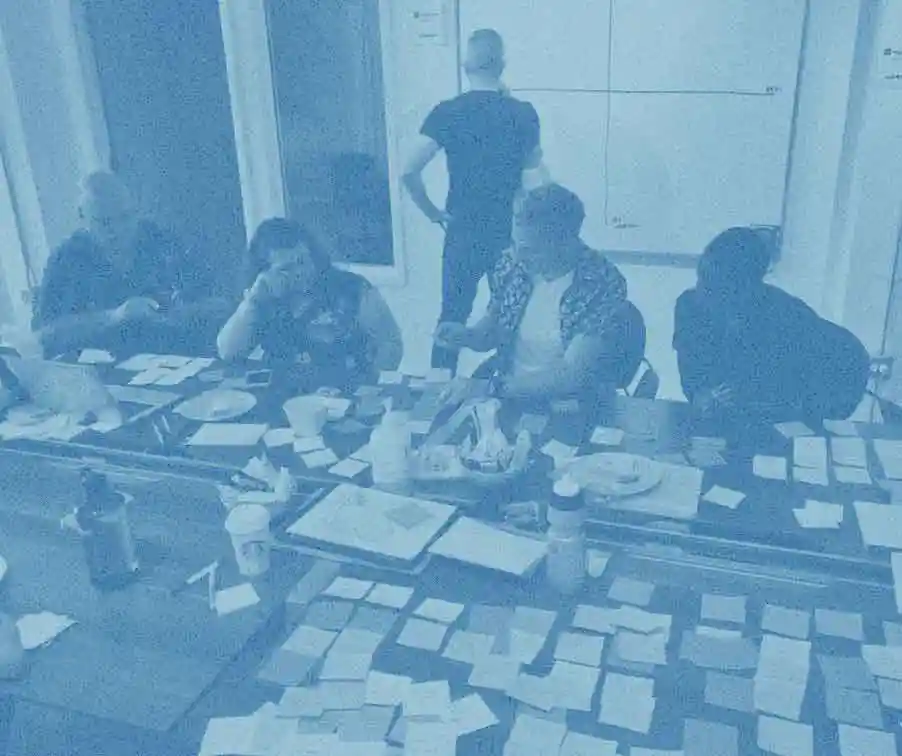Fair Work
Here’s how Mightybytes supports fair work in our business strategy and operations based on new B Corp performance requirements.

Team
Well-Being
Under new B Corp standards, Certified B Corps are expected to incorporate fair work principles into daily operations. This includes equitable employment contracts, interview processes, wage and benefit practices, flexible scheduling, and more. Details on how Mightybytes complies with these new requirements are below.
New B Corp standards differ from company to company based on a variety of criteria, including company size, location, and revenue. The standards below reflect those required for a small service business with a minor environmental footprint.
Fair Work is about building workplaces where employees feel valued, heard, and empowered. When businesses prioritize Fair Work, they create environments where workers thrive–and when workers thrive, companies do too.
— Bernard Grouw, Senior Social Standards Manager, B Lab Global
1.1.1 All employees have an employment contract or offer letter meeting the following criteria.
- It is written in a language the employee understands.
- It is signed by a company representative and the employee.
- It includes:
- the name of the company
- the names of both signing parties
- the nature and place of the work
- working hours
- the base wage
- any extra wage components
- the work start date
- the duration of the work
- conditions for termination.
1.1.2 If an employee is already working without a written contract or offer letter, the company provides a letter that meets the criteria above
1.2.3 All employees receive a copy of their employment contract or offer letter from the company.
Onboarding Team Members
We create employment contracts for all employees and follow a clear onboarding process to ensure expectations are met for everyone.
Our hiring and onboarding process for new employees is as follows:
- Position listing: A position listing with salary range, benefits, and description of duties is posted to the Mightybytes website and other online resources.
- Interviewing: After multiple interviews with potential candidates, including several with relevant Mightybytes team members, an offer letter is drawn up and a copy of the company’s employee manual provided to the chosen candidate.
- Position roadmap: If the offer is accepted, Mightybytes team members and the candidate co-create a non-binding position roadmap based on the listing that outlines aspirational goals.
- Employment contract: An employment contract that includes the points listed above under Compliance Criteria is provided for the candidate and hiring manager to sign.
- Training documentation: Upon signing, Mightybytes provides training and onboarding documentation for our new teammate so they can build the skills necessary to find success in their new position.
- Trial period: Check-ins are scheduled within a 90-day period to ensure expectations for all parties are being met.
1.2.1 If the company uses variable schedules, it has a policy that states the following:
- The specific cancellation deadline that applies equally to both the company and employee.
- That the company will pay the employee in full when cancelling their work after the deadline for reasons within the company’s control.
- Whether the company will pay the employee, and how much, when cancelling their work after the deadline for reasons outside the company’s control.
1.2.2 The company makes the policy available to all employees that work variable schedules.
Flexible Scheduling
Mightybytes supports flex time in situations where an employee needs to be out during typical working hours.
Given the high-touch nature of our work with clients, Mightybytes does not use variable schedules for employees. Our full-time employees are salaried. If a client cancels a project, employees are paid regardless.
2.1.1 The company has a policy or procedure that states it does not ask job applicants to provide:
- their wage histories
- their preferred wage (unless the company first shares a wage scale).
Salary Listings
Mightybytes includes salary ranges (maximum $10,000 range) in all position listings.
We do not request wage histories from potential employees. New hires are welcome to negotiate salary or terms if an offer is made.
2.2.1 The company tells workers about:
- all wage components relevant to them
- all benefits they are entitled to
- the mechanisms it uses for setting and reviewing wages and benefits.
2.2.2 All employees regularly receive payslips or equivalent containing clear information about, at minimum, their:
- base wage
- extra wage components
- deductions.
2.2.3 Payslips are written in a language the employee understands.
Benefits & Salary Ranges
Mightybytes shares salary ranges and high-level benefits package details in open position listings and more detailed descriptions in step two of our hiring and onboarding process above.
Several factors inform this practice:
- Living wage as the baseline
- Research on industry, region, and position salary benchmarks
- What the company can reasonably afford, given our client base of primarily nonprofits, educational institutions, associations, and social enterprises
- Keeping a low-to-high company salary range within a ratio of 1-to-1.5
2.8.1 The company chooses and implements one of the following:
- FW2.8.a The company pays employees a living wage
- FW2.8.b The company pays employees a collectively-bargained wage
- FW2.8.c The company calculates its living wage gap, creates a closure plan, and meets two additional criteria.
Negotiating Fair Pay
Mightybytes is committed to fair wage practices and offers any new employees a living wage as a baseline. Position requirements play a role in decision-making and salary range listings.
As noted above, new hires are welcome to negotiate a higher salary as part of the hiring and onboarding process. Similarly, team members can negotiate salary adjustments at any time. Mightybytes’ ability to meet these requests is impacted by our ability to consistently close new projects with values-aligned clients.
3.2.1 The company seeks, considers, and addresses worker feedback on decisions that affect them.
3.2.2 The company seeks feedback from the workers affected by a decision, or their representative.
3.2.3 The company communicates its decision and how it considers feedback back to the relevant workers, or their representative.
Internal Communications
With a small team, we pride ourselves on maintaining open, ongoing lines of communication with each other and with our clients. Good collaboration and communication are cornerstones of our company’s success.
- Feedback: The company has an open door policy for sharing feedback. Team members can offer feedback or ask clarifying questions at any time.
- Job satisfaction: The company directly solicits feedback from employees about job satisfaction on at least an annual basis.
- Strategy: The company actively seeks feedback from our team on an ongoing basis about important decisions, including strategic direction, vetting clients, and organizational policies during quarterly meetings and as needed when new opportunities arise.
- Customer feedback: We also solicit feedback from customers, which can, in turn, impact company decisions that affect employee policies.
4.1.1 The measurement focuses on outcomes for workers.
4.1.2 The measurement includes at least two of the following themes.
- Satisfaction
- Wellbeing
- Belonging
- Feeling engaged
- Being engaged
- Psychological safety
4.1.3 The company states in its communications about the measurement that participation is optional.
4.1.4 The company completes the measurement:
- in the twelve months before Year 0
- in each subsequent year.
4.1.5 The measurement is done annually.
4.1.6 If the company has 50 workers or more (based on headcount) then:
- The measurement is both qualitative and quantitative.
- The measurement is anonymous by default. Where anonymity cannot be ensured, the company informs workers.
Measuring Workplace Culture
Good working relationships are based on trust, collaboration, and mutual respect. Understanding and improving workplace culture over time are key to creating continued, shared success.
Here’s how we measure workplace culture at Mightybytes.
- Qualitative: We ask team members about how to improve important workplace culture indicators at quarterly meetings.
- Qualitative: We schedule one-on-one conversations between team members and leadership at least once per year.
- Qualitative: We run project retrospective meetings after large project milestones to understand what we learned, what we did well, and where we could improve.
- Quantitative: Polls to understand team satisfaction, wellbeing, engagement, belonging, and other factors are shared at least once per year. When shared, we make it clear that participation is optional.
4.2.1 The company develops and implements a plan to improve its workplace culture.
4.2.2 The actions in the plan are based on the company’s measurement of its workplace culture.
4.2.3 The plan is approved by the executive team or highest governing body.
4.2.4 The plan is updated to show progress on each action.
4.2.5 The company updates the plan and shares it with its workers annually.
4.2.6 If fewer than 50% of workers participate in the workplace culture measurement, the company includes actions in the plan to increase participation.
Improving Workplace Culture
As a small, virtual company, Mightybytes has already made these commitments:
- We meet in-person at least quarterly to improve relationships and collaboration.
- We have an ongoing company commitment to team upskilling and training.
- We dedicate time to discuss workplace culture during quarterly team meetings.
- We schedule team activities to improve relationships.
We are currently working on a company Workplace Culture Plan and will add the document to this page once complete.
Related
Content
Finally, to help others, Mightybytes publishes articles under the Business Strategy section of our blog and on B the Change, the storytelling platform for the global B Corp community. We cover important lessons learned on our journey operating a social enterprise agency.
See the list below for content related to workplace culture and the Fair Work impact topic.
- Redesigning How We Work
- Five Business Management Strategies we Learned as a B Corp
- Seven Tips for Better Creative Collaboration
- Six Ways to Create Shared Value
- Improve Your Company’s Inclusion Practices by Doing This
- Triple Bottomed Out: How I Learned to Stop Worrying and Love My Company Again
- 7 Alternatives to ‘Scaling’ Your Business
- Agencies of Change (three part series)
Still have B Corp Questions?
Want to learn more about how Mightybytes uses our B Corp certification to create positive change across communities and ecosystems? Schedule a conversation with Tim.
